Ceviche is the famous dish from Latin America where fresh fish and other seafood is “cooked” in lime juice and mixed with chilli, coriander/cilantro, onion and other flavourings. Also known as cebiche, seviche or sebiche, this quick and easy recipe makes a wonderful light meal for hot summer days, or an elegant starter.
The one thing that makes this ceviche recipe stand out from the rest is that it’s not too sour. Limes in South America aren’t as sour as ours!
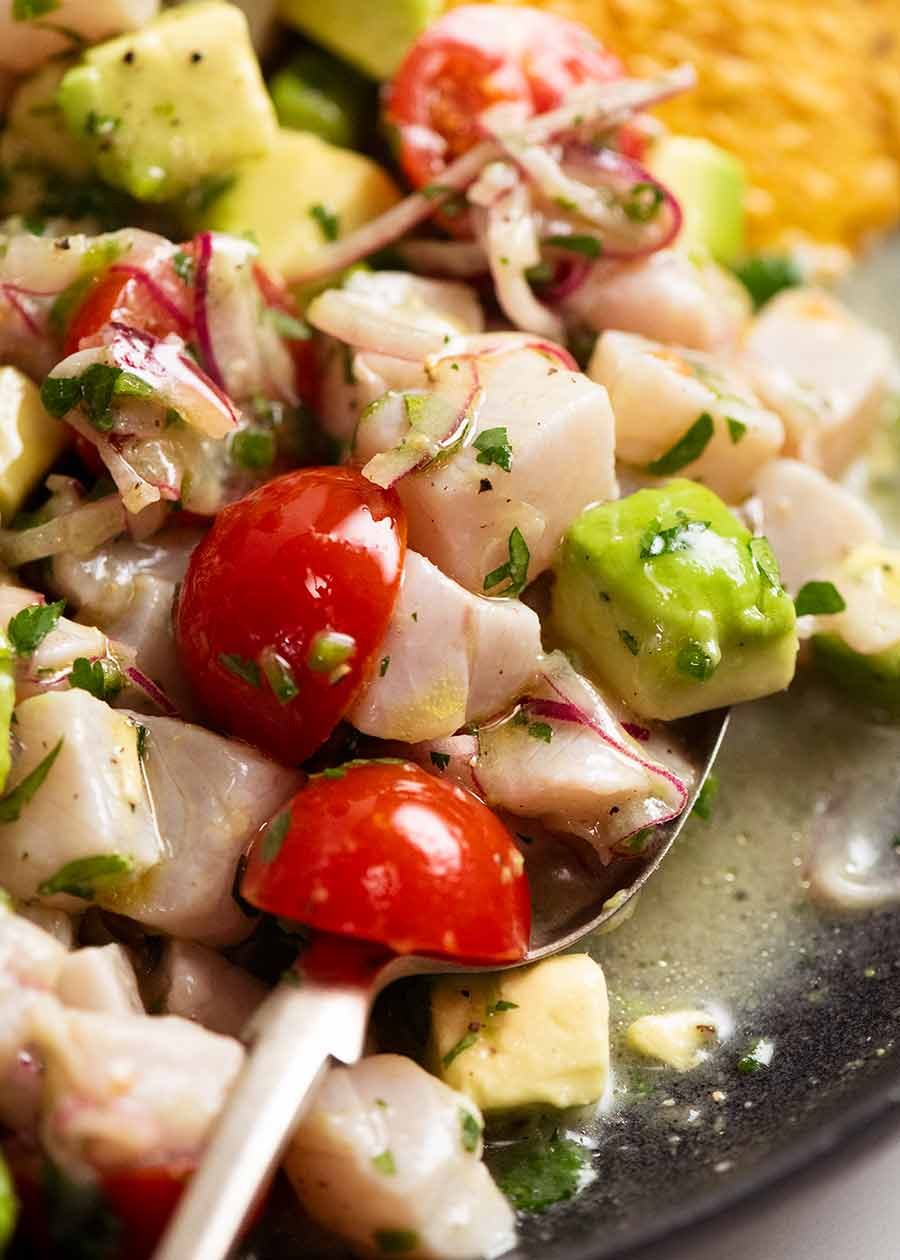
Ceviche
Originating from the west coast of South America, today ceviche can be found in various forms from Mexico down to Peru and beyond. It’s also a dish that has been embraced by fine dining establishments around the world. It plates up elegantly and is an ideal light seafood starter to precede a richer main.
Plus, it’s the sort of dish that people don’t ordinarily think of as simple to make at home, so restaurants readily charge a small fortune for it.
I’m here to bust that myth! As long as you can get your hands on sparkling fresh fish, ceviche is dead easy to make – and super quick too!
Buying sashimi-grade fish suitable for raw consumption is readily available these days, making dishes like ceviche infinitely accessible for ordinary folk like ourselves!
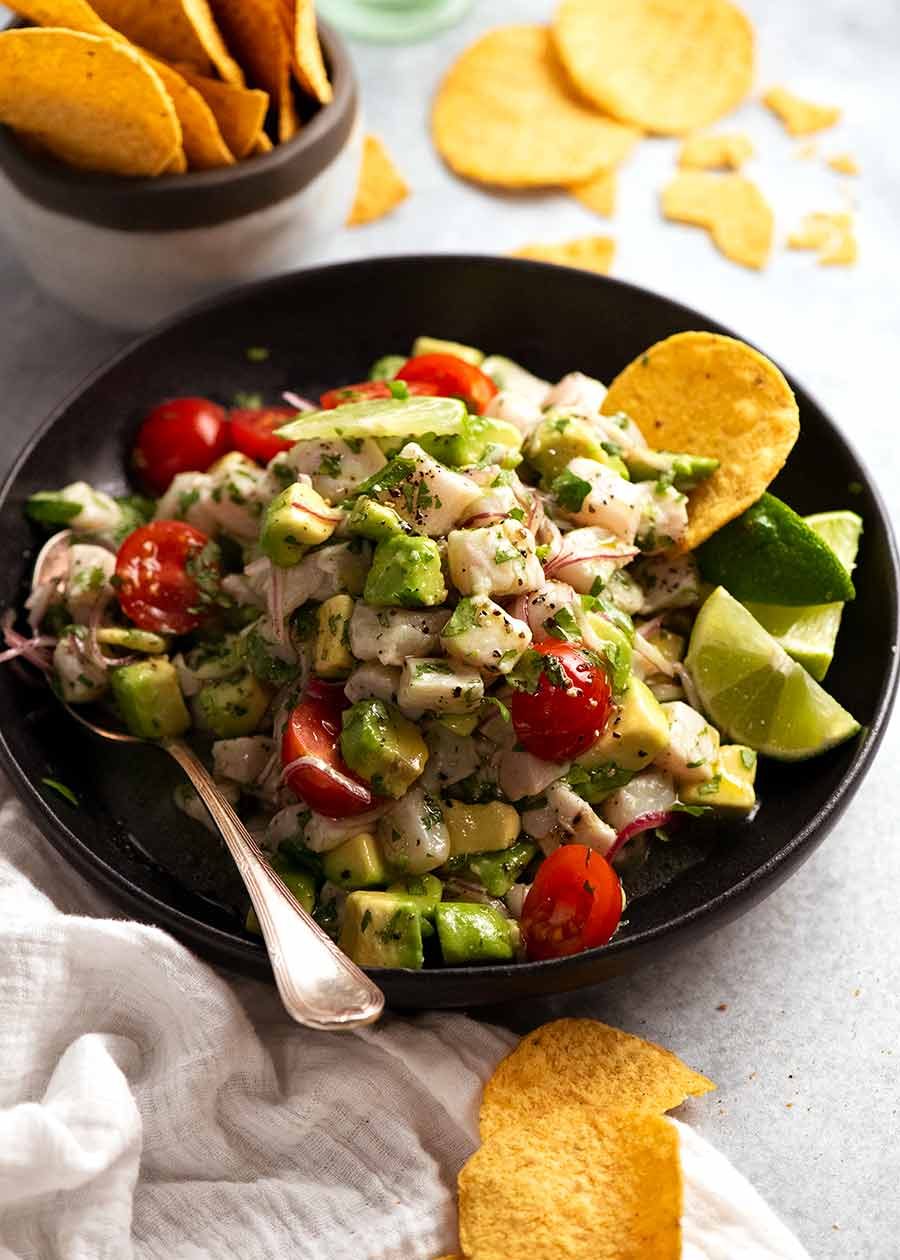
Raw fish + lime juice + 5 minutes = Ceviche!
At its core, Ceviche is as simple as tossing raw fish with lime juice, then leaving it for 5 minutes to let the acid “cook” the fish, making it turn white on the surface, but still raw inside.
Here’s a comparison of the fish immediately after tossing with lime (fish is still translucent), then 5 minutes later, it’s turned white because it’s cooked!
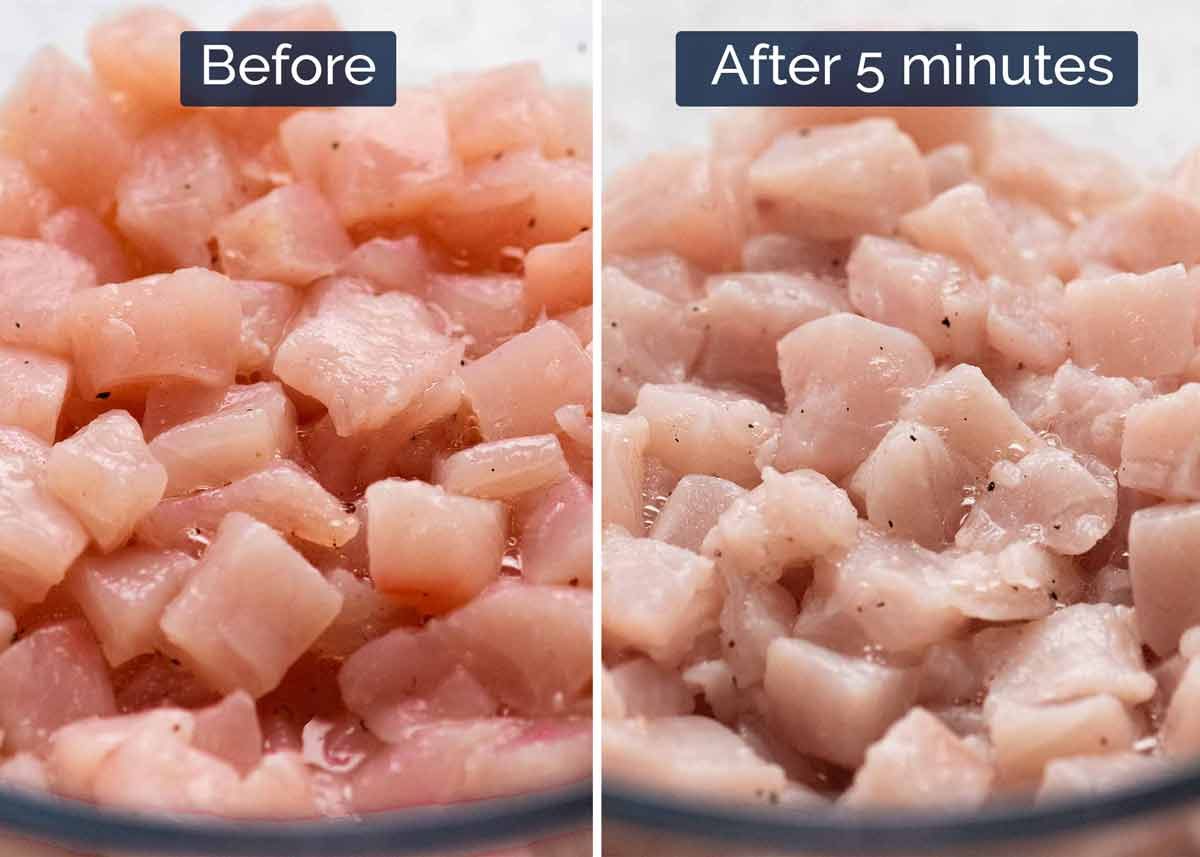
It MUST be sashimi-grade fish
The ONLY fish you should use for ceviche is sashimi-grade fish that is suitable for raw consumption. It is not enough to just buy “fresh fish” from the stores – this only means it’s considered generally “fresh” from the fishmonger’s standpoint. It does not mean it’s necessarily fresh enough to eat raw. You need to check with the fish monger that it is “sashimi grade” (usually it will be helpfuly labelled 🙂 ) and is safe it eat raw.
I know that the thought of eating raw fish from the fishmonger versus at a restaurant might make some people nervous, but food safety standards nowadays here in Australia are such that you shouldn’t have cause for concern. I’ve been eating store-bought raw fish all my life since it became available in the late 90’s and I’ve never had a problem.
Of course, if you happen to have a fisherman friend, you can use virtually any freshly-caught fish – it’s all sashimi-grade! As a child, before sashimi was widely consumed in Australia, my parents would take us fishing every weekend just so we could catch fresh fish for sushi!

Best fish for ceviche
There is no one way to make ceviche, and there is no single “best fish” for ceviche because it’s driven by the types of seafood available in different regions! There’s plenty of options, so I’m going to list the most common ones for you:
Kingfish (pictured above) – prized for it’s soft white flesh, very popular in Japanese sashimi (shows how good this fish is!). This is one of 3 common sashimi-grade fish sold at Australian fish shops (along with salmon and tuna) and a popular choice of fine dining establishments;
Sea bass – traditionally used for Peruvian Ceviche and easily found in the UK/US;
Tuna – popular in Mexico (along with prawn/shrimp);
Mackerel – also popular in Mexico;
Prawns / shrimp – traditional in Ecuador and popular in Mexico, often with a dash of tomato juice;
Halibut or Patagonian tooth fish – Chile;
Salmon – though not traditional (because white fish is traditional), salmon is excellent made into ceviche. Easy to find in Australia;
Bream – many species, depending where in the world and widely used;
Swordfish – if you are lucky enough to get it(!), this is used in some Latin American countries.
Trevally – Although we haven’t seen it mentioned, raw trevally is beautifully soft-textured and would make a fine ceviche. Available at some good fishmongers here in Australia; and
Cod and mahi mahi – Popular options in America.
Fish that is not suitable for Ceviche
As a general rule, fish that are tender and not chewy when raw will make better ceviche. This is because the fish in ceviche is cut chunkier compared to the fine slices used in say fish carpaccio or sushi. Thus fish like snapper, grouper, some cods, flounder, which can be sometimes a bit tough eaten raw, are less suitable.

There’s no one way to make ceviche. Each country, city, restaurant and household has their own way. At its core, however, the avocado and jalapeño in this makes this a Mexican Ceviche.
What (else) goes in Ceviche
Here are the other ingredients required for this recipe:
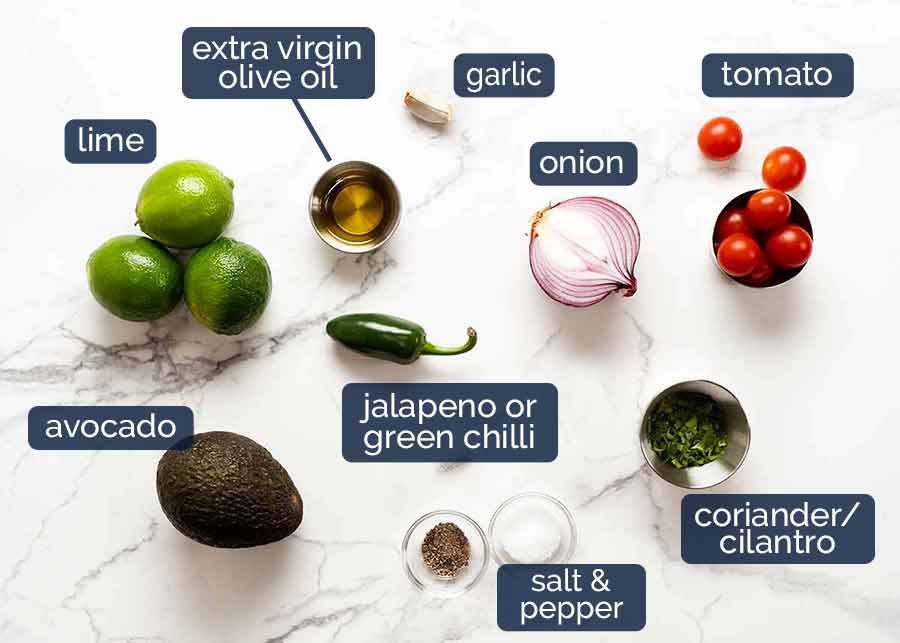
Limes – the essential ingredient that “cooks” the fish;
Extra virgin olive oil – just a touch will take the sharp, sour edge off the otherwise totally sour dish. It’s not strictly traditional to include this, but it’s important to know that limes in Latin America – certainly in Mexico – are often not as sour as those in most Western countries, including Australia and the US. Without oil, I find Ceviche is too sour. Even in Mexico, I found most Ceviches there to be too sour! (*She ducks as Mexicans throw rotten tomatoes at her!*)
Avocado and jalapeño – these add ins are traditional in some versions of Ceviche found in Mexico. Creamy pieces of avocado are a sensational pairing with the delicate pieces of fish!
Coriander/cilantro – essential fresh herb flavouring for ceviche. Coriander haters – sub with chives;
Red onion – very finely sliced so it flops and melds with the fish;
Garlic – crushed using a garlic press so it’s minced finely and “juicy”. We just use 1 small clove – it shouldn’t be overly garlicky; and
Tomato – included in some traditional versions, I really love just adding a bit (not too much) for beautiful pops of colour and fresh juiciness.
How to make Ceviche
The making part is very simple, but I’ve found the key is the order in which ingredients are added – ie what is marinated with the fish, and what is best added later.
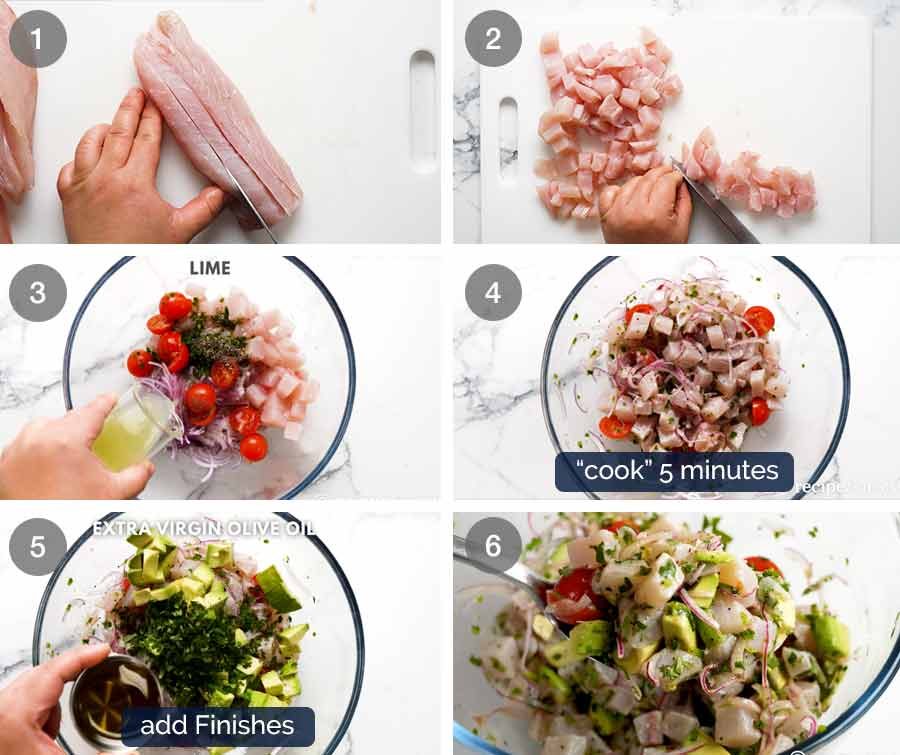
Fish – cut the fish into long strips;
Dice – then cut it into small cubes;
Combine fish with tomato, onion, jalapeño, pepper and lime juice. Do not add salt (this draws water out of the fish), avocado (these get bashed around too much when tossing) or olive oil (this dilutes the acidity of the lime juice and slows down the cooking too much);
“Cook” 5 minutes – gently mix, then set aside for 5 minutes to let the lime “cook” the fish;
Add olive oil, avocado, fresh herbs, salt then gently mix;
Serve immediately.
Despite what other recipes will tell you, there’s no need to be in a manic rush to get the ceviche on the table within 10 seconds otherwise the lime will over cook the fish. Ceviche is certainly best eaten fresh, but it’s still wonderful 20 minutes later. It’s not until around the 30 minute mark that the fish becomes a bit too firm for my taste (literally completely cooked through – but not like stove cooking so it’s not the best texture).
Note: In some countries (such as Peru), ceviche is traditionally left to “cook” for several hours in the lime but larger pieces of fish are used. I like using small pieces – for better texture and ease of eating.


How to serve Ceviche
Just as there is no one way to make Ceviche, there are plenty of ways to serve it too!
In Mexico and other parts of Central America, it’s often served in small “cups” or dishes , cocktail style, with corn chips or crispy tortillas/tostadas for scooping, as pictured above. I like using this idea to make platters of canapés to pass around at gatherings, as pictured on the below right.
In Peru it’s served as a meal with corn on the cob, slices of cooked sweet potato and sometimes with rice. In other countries it comes with plantain chips or rice.
In fine dining restaurants, it’s served in all sorts of fancy ways. One easy way is to spoon individual portions into a small dish with a side of crostini on the side (toasted small bread), as pictured below.
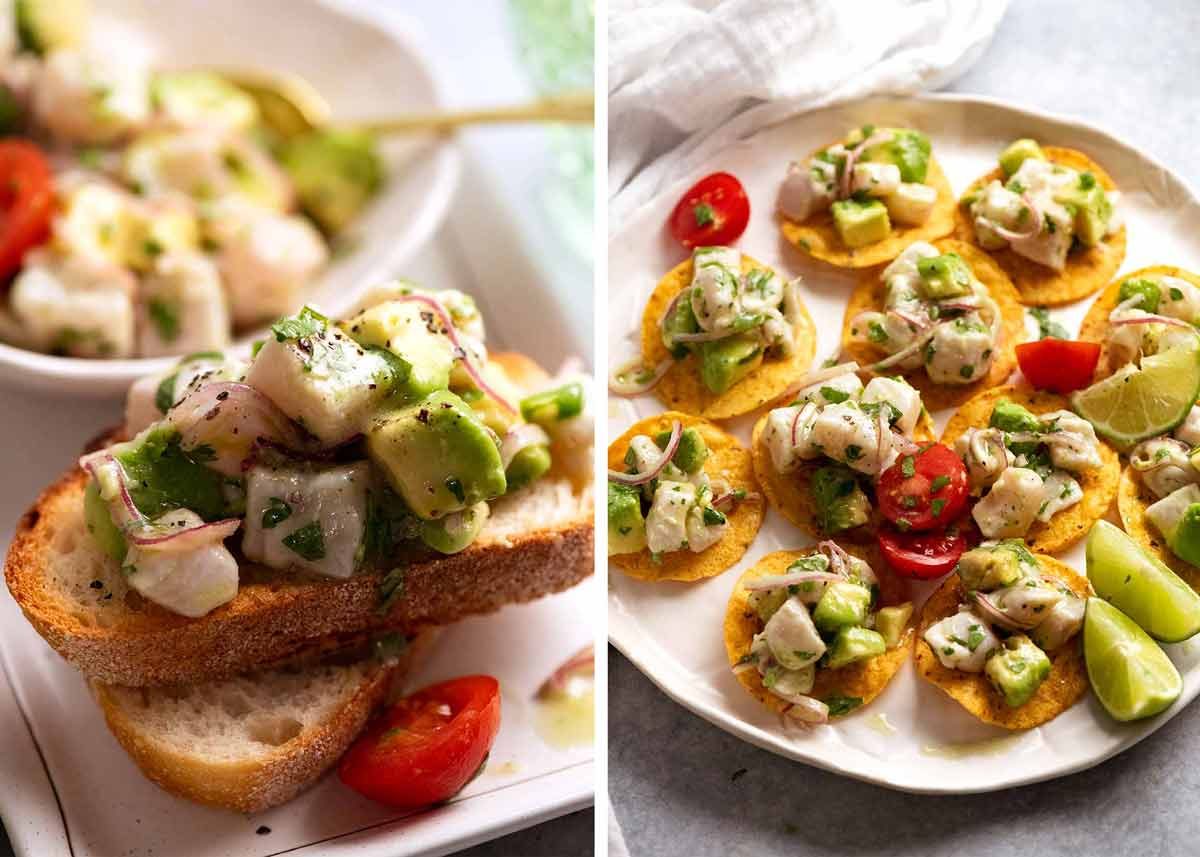
Of course, you can just by-pass all of that and just devour it straight out of the bowl with a spoon, which is exactly what I did. 🙂
I really hope you give this a go one day. Especially those of you who have previously been turned off by overly sour ceviche in the past.
Now – go make friends with some local fishermen! 😂 – Nagi x
Watch how to make it
Hungry for more? Subscribe to my newsletter and follow along on Facebook, Pinterest and Instagram for all of the latest updates.

Ceviche
Ingredients
“Cooked” fish:
- 400g / 14 oz kingfish, tuna, sea bass or other sashimi-grade fish suitable for raw eating (Note 1)
- 1/4 red onion , very finely sliced using mandolin (so it "flops")
- 2 tsp fresh jalapeño , finely chopped (or green chilli) – add more or less for spiciness
- 8 cherry tomatoes , halved (large ones quartered)
- 1/4 tsp black pepper
- 1/3 cup lime juice , fresh (or lemon juice)
Add ins:
- 1/2 tsp salt , cooking / kosher (or 1/4 tsp table salt, Note 2)
- 1 avocado , ripe, cut into 1.25cm / 1/2″ cubes
- 1/4 cup coriander/cilantro leaves , roughly chopped (sub chives)
- 2 tbsp extra virgin olive oil (Note 3)
Instructions
- Cut fish: Cut fish into 1.25cm / 1/2" cubes.
- Toss in lime, leave 5 minutes: Place in a bowl with onion, jalapeño, tomato, pepper and lime juice. Gently toss, then set aside for 5 minutes, mixing gently once.
- Add avocado then serve! Sprinkle over salt, then add avocado, coriander and olive oil. Gently stir, then serve immediately with corn chips (see in post for other ideas).
- Ceviche will be good for 20 minutes or so, then fish will start to overcook and firm up. Do not leave overnight (for food safety reasons).
Recipe Notes:
- Kingfish (pictured in post)- popular choice of fine dining establishments
- Sea bass – traditional in Peruvian
- Tuna and mackeral – popular in Mexico
- Prawns / shrimp – traditional in Ecuador, popular in Mexico
- Halibut or Patagonian tooth fish – Chile
- Salmon – not traditional but excellent for ceviche
- Bream – many species all around the world
- Swordfish – used in some Latin American countries.
- Trevally – not traditional in South America, but beautifully soft-textured and excellent for ceviche
- Cod and mahi mahi – Popular options in America.
Nutrition Information:
More Fresh Fish recipes
More recipes that make the most of sparkling fresh fish!
Life of Dozer
Lazy bugger – stretching out as far as he can to rescue his toy because he can’t be bothered to dive back in. Can you imagine if pool Lifeguards had the same attitude?? I’m gonna stretch out to try to save you, but if I can’t reach you without getting my feet wet then too bad, I’m gonna leave you floating facedown in the pool! 😂

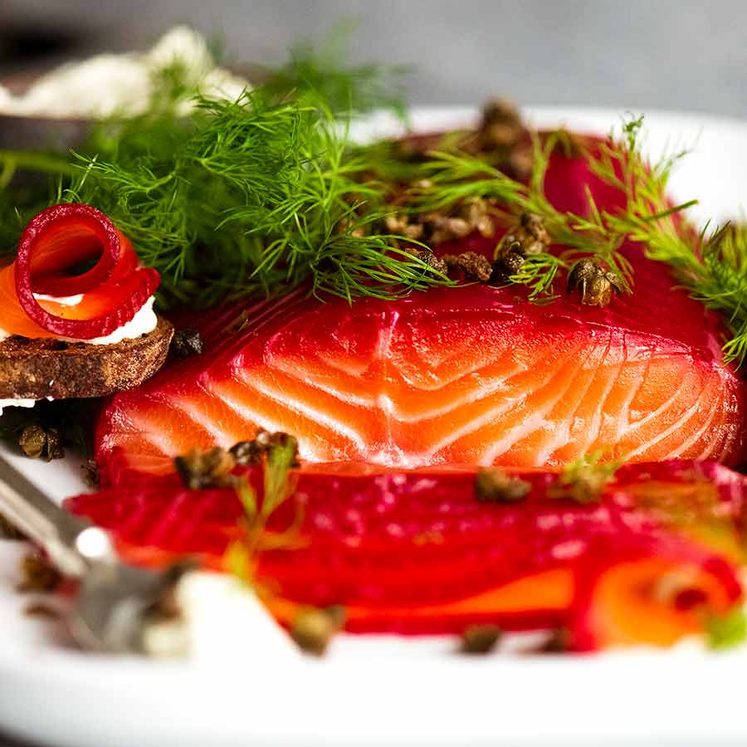
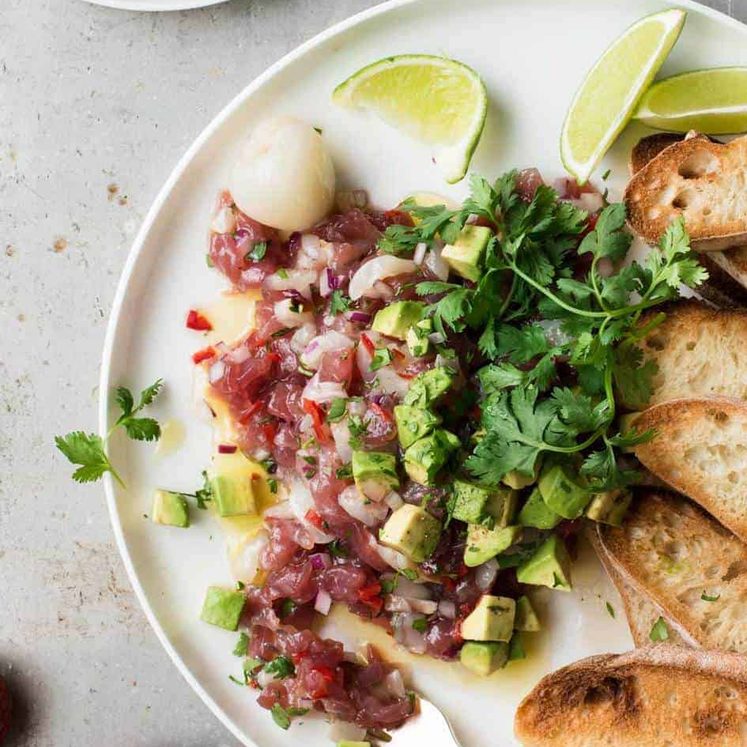
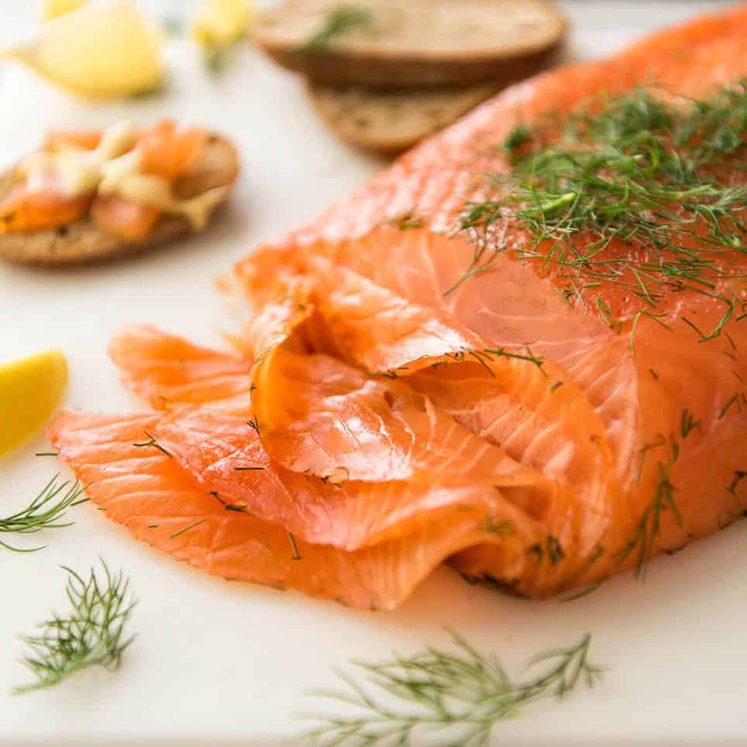
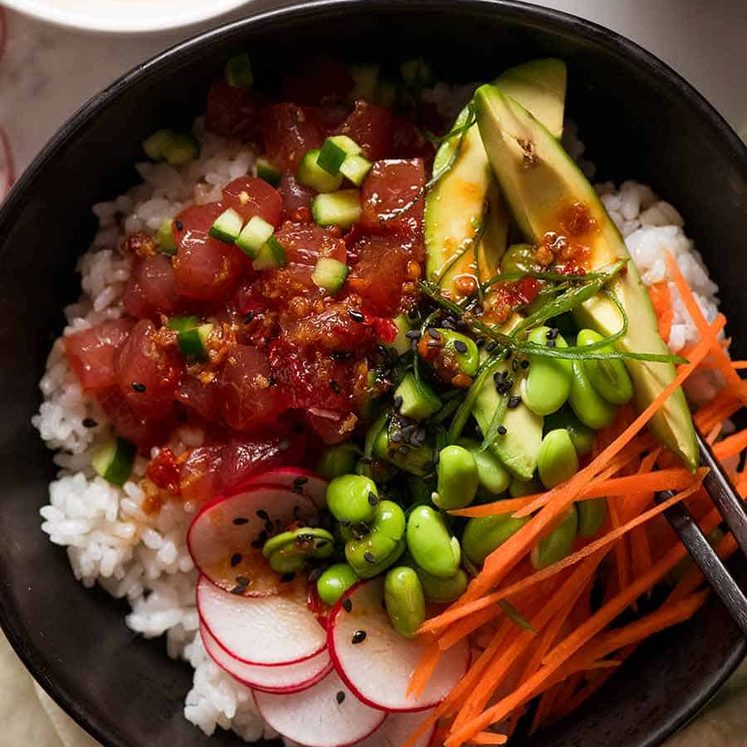
Hi Nagi and Dozer,
Greetings from Sydney!
I love ceviche as it brings up so many nice memories from my time in South America (where I am originally from). One very nice alternative for serving it is to use plantain chips instead of corn chips.
And my favourite fish is King Fish.
Cheers
NSW, Australia.
I like all sorts of fish – really depends on the dish BUT one fish that I steer away from is Basa.. I know it’s one of the most economical types to buy and tastes great in a lot of dishes, but I had the chance to see first hand where basa fillets are from (Vietnam) and … let’s just say, I was turned off, and there is a reason for the cheaper price tag 😝
Brings back memories of the first time I had ceviche on vacation in Mexico; kept going back for more! I’m from Sutton, Ontario, Canada, and my favourite fish is fresh caught salmon from another Canadian province, British Columbia.
I’m from Bellevue, Washington in the US. I like cod with lemon and Garam masala. Made your your carnitas recipe for dinner and it is brilliant! Thanks for the great recipes!!!
Hello from Singapore 🙂
My favourite raw fishes are Tuna and Salmon.
However, not a fan of cod fish and sardines.
love your recipes!
Would scallops be suitable for ceviches?
Hi..I am from Seremban, Malaysia! Have not eaten ceviche before but we do have shashimi in the Japanese restaurants and also Loh Sang..which is a MUST HAVE dish for Chinese New Year as a starter..raw fish combined with lots of condiments! Meanwhile, will have to make do with salmon for this dish haha! Thx for sharing this..
Hi Ngai, I am from Ontario, Canada. Not a fan of fish but I like tilapia. Great website! And thank you for all your recipes. Have try many and loved them all.
Oregon, USA here. Prawns are my favorite for ceviche but my favorite fish is salmon.
Another Nagi/recipetin recipe or two will be used tonight. Easy recipes with mouth watering videos- I love it.
Poor Dozer. Does his haircut show when he wears his robe?
Hi Nagi,
I am from Victoria, Australia and I love your recipes and seeing what Dozer gets up to every time!
Thanks for your generosity with the giveaway..something to look forward to in lockdown!
As for my favourite fish, I haven’t got any because I like all fish dishes I’ve had so far 🙂
Hello from South Dakota USA. Our favorite fish is tilapia.
Kingfish everytime!
Thanks for all you do Nagi, we average 1-2 of your epic recipes per week – the best! (local Werribee, Victoria)
I’m not a big seafood eater but I do like mild tasting fish like cod and whitefish. I never buy fish from a market. I order cod in restaurants and will cook whitefish or steelhead at home that my son catches from Lake Huron, which I live very near here in Au Gres, Michigan, 48703. 🇺🇸
Hello Nagi – I hail from Richmond Virginia USA. My fav is fresh swordfish. Thanks for introducing me to ‘oyster sauce’!
Hi Nagi,
I love kingfish, salmon and tuna ceviche.
The best ceviche I ever had was salmon on Easter Island last year. It was delicious.
Our local Vietnamese restaurant called Hanoi Mee does Kingfish ceviche which is to die for. Can’t wait to dine there again when lockdown ceases.
In the meantime I will try your recipe. Would be great to have a special knife to help in the preparation !
Russell
Port Melbourne
Victoria
I love cod fish, although… never tried it in ceviche before. We usually do a Filipino version of ceviche called Kinilau. Can’t wait to try your version.. as soon as I can get my hands on some fresh kingfish!
I live in Oregon in the United States. I like sea bass and ling cod. I would love the Japanese knife like the other 5, 749 fans of yours. I love your recipes, there is not a bad one in the bunch and have recommended your website to several friends. Thanks for taking the time to create it.
Hello from the lockdown capital of Australia…Melbourne, Victoria!
I sooo miss being able to enjoy the simple things in life like sitting with friends over a good meal!
I’m not a huge seafood eater but I do love wasabi prawns wrapped in bacon served on top of bok choy!
Thanks for having this awesome giveaway!
Ainsley
Mornington Peninsula
Victoria
I love the sound of the wasabi prawns. I particularly love flathead tails and smallish whole leatherjacket-delicious on the BBQ. Thanks Nagi for so many great recipe and this fabulous giveaway – my recipe draw is overflowing with the meals that the kids I make regularly. Favourites- caramel pork, prawn ricepaper rolls, honey chicken. We live on the Mornington Peninsula in VICTORIA ! happy friday lisa
Hi Nagi! I live in Vancouver British Columbia, Canada. I love Sea Bass and Ahi Tuna and all your recipes! Thank You!
Victoria, Australia
Swordfish is great!
Combining the freshest of fish with such zingy flavours and smooth, luscious avocado – what a treat! I like many types of fish but particularly sustainably fished ones, including Australian salmon (salmon trout). Thanks, as always, Nagi – your recipes are no-fail and always exciting. – Lisa from South Australia